Shark attack
| Shark attack | |
|---|---|
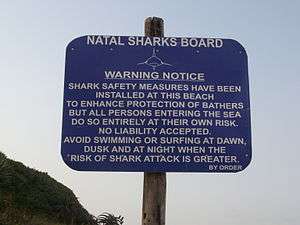 | |
| A sign warning about the presence of sharks off Salt Rock, South Africa | |
| Classification and external resources | |
| ICD-10 | W56 |
| ICD-9-CM | E906.3 E906.3 |
A shark attack is an attack on a human by a shark. Every year, around 80 unprovoked attacks are reported worldwide.[1] Despite their relative rarity, many people fear shark attacks after occasional serial attacks, such as the Jersey Shore shark attacks of 1916, and horror fiction and films such as the Jaws series. Out of more than 489 shark species, only three are responsible for a double-digit number of fatal, unprovoked attacks on humans: the great white, tiger, and bull.[2] The oceanic whitetip has probably killed many more castaways, but these are not recorded in the statistics.[3]
Statistics
| Region | Total attacks |
Fatal attacks |
Last fatality |
|---|---|---|---|
| United States (Excluding Hawaii) | 1104 | 35 | 2018 |
| Australia | 536 | 72 | 2017 |
| Africa | 346 | 94 | 2015 |
| Asia | 129 | 48 | 2000 |
| Hawaii | 137 | 10 | 2015 |
| Pacific Islands / Oceania (Excluding Hawaii) | 126 | 49 | 2016 |
| South America | 117 | 26 | 2015 |
| Antilles and Bahamas | 70 | 16 | 2013 |
| Middle America | 56 | 27 | 2011 |
| Europe | 52 | 27 | 1989 |
| New Zealand | 49 | 9 | 2013 |
| Réunion Island | 39 | 19 | 2017[4] |
| Unspecified / Open ocean | 21 | 7 | 1995 |
| Bermuda | 3 | 0 | — |
| Total: | 2,785 | 439 | 2017 |
| Sources: Australian Shark Attack File for unprovoked attacks in Australia International Shark Attack File for unprovoked attacks in all other regions | |||
According to the International Shark Attack File (ISAF), between 1958 and 2016 there were 2,785 confirmed unprovoked shark attacks around the world, of which 439 were fatal.[5]
In 2000, there were 79 shark attacks reported worldwide, 11 of them fatal.[6] In 2005 and 2006, this number decreased to 61 and 62 respectively, while the number of fatalities dropped to only four per year.[6] The 2016 yearly total of 81 shark attacks worldwide was on par with the most recent five-year (2011–2015) average of 82 incidents annually.[7] By contrast, the 98 shark attacks in 2015, was the highest yearly total on record.[7] There were four fatalities worldwide in 2016, which is lower than the average of eight fatalities per year worldwide in the 2011–2015 period and six deaths per annum over the past decade.[7] In 2016 58% of attacks were on surfers.[7]
Despite these reports, however, the actual number of fatal shark attacks worldwide remains uncertain. For the majority of Third World coastal nations, there exists no method of reporting suspected shark attacks; therefore, losses and fatalities near-shore or at sea often remain unsolved or unpublicized.
Of these attacks, the majority occurred in the United States (53 in 2000, 40 in 2005, and 39 in 2006).[8] The New York Times reported in July 2008 that there had been only one fatal attack in the previous year.[9] On average, there are 16 shark attacks per year in the United States, with one fatality every two years.[10] According to the ISAF, the US states in which the most attacks have occurred are Florida, Hawaii, California, Texas and the Carolinas, though attacks have occurred in almost every coastal state.[11]
Australia has the highest number of fatal shark attacks in the world, with Western Australia recently becoming the deadliest place in the world for shark attacks[12] with total and fatal shark bites growing exponentially over the last 40 years.[13] Since 2000 there have been 15 fatal shark attacks along the West Australian coast[14] with divers now facing odds of one in 16,000 for a fatal shark bite.[13][15]
Other shark attack hotspots include Réunion Island,[16] Boa Viagem in Brazil, Makena Beach, Maui, Hawaii and Second Beach, Port St. Johns, South Africa.[17] South Africa has a high number of shark attacks along with a high fatality rate of 27 percent.[18]
As of June 28, 1992, [19] Recife in Brazil began officially registering shark attacks on its beaches (mainly on the beach of Boa Viagem). Over more than two decades, 62 victims were attacked, of which 24 died. The last deadly attack occurred on July 22, 2013.[20] The attacks were caused by the species bull shark and tiger shark. [21] What shocks about the shark attacks in Recife is that so many of them are fatal - 21 of the 56, a death rate of about 37%. This is much higher than the worldwide shark attack fatality rate, which is currently about 16%, according to Florida State Museum of Natural History.[22]
The location with the most recorded shark attacks is New Smyrna Beach, Florida.[23] Developed nations such as the United States, Australia and, to some extent, South Africa, facilitate more thorough documentation of shark attacks on humans than developing coastal nations. The increased use of technology has enabled Australia and the United States to record more data than other nations, which could somewhat bias the results recorded. In addition to this, individuals and institutions in South Africa, the US and Australia keep a file which is regularly updated by an entire research team, the International Shark Attack File, and the Australian Shark Attack File.
The Florida Museum of Natural History compares these statistics with the much higher rate of deaths from other causes. For example, an average of more than 38 people die annually from lightning strikes in coastal states, while less than 1 person per year is killed by a shark in Florida.[24][25] In the United States, even considering only people who go to beaches, a person's chance of getting attacked by a shark is 1 in 11.5 million, and a person's chance of getting killed by a shark is less than 1 in 264.1 million.
However, in certain situations the risk of a shark attack are higher. For example, in the south west of West Australia the chances of a surfer having a fatal shark bite in winter / spring are 1 in 40,000 and for divers it is 1 in 16,000.[13][15] In comparison to the risk of a serious or fatal cycling accident, this represents 3 times the risk for a surfer and 7 times the risk for a diver.[13]
Species involved in incidents
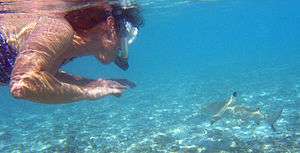
Only a few types of sharks are dangerous to humans. Out of more than 480 shark species, only three are responsible for two-digit numbers of fatal unprovoked attacks on humans: the great white, tiger and bull;[2] however, the oceanic whitetip has probably killed many more castaways which have not been recorded in the statistics.[3] These sharks, being large, powerful predators, may sometimes attack and kill people; however, they have all been filmed in open water by unprotected divers.[26][27] The 2010 French film Oceans shows footage of humans swimming next to sharks in the ocean. It is possible that the sharks are able to sense the presence of unnatural elements on or about the divers, such as polyurethane diving suits and air tanks, which may lead them to accept temporary outsiders as more of a curiosity than prey. Uncostumed humans, however, such as those surfboarding, light snorkeling or swimming, present a much greater area of exposed skin surface to sharks. In addition, the presence of even small traces of blood, recent minor abrasions, cuts, scrapes or bruises, may lead sharks to attack a human in their environment. Sharks seek out prey through electroreception, sensing the electric fields that are generated by all animals due to the activity of their nerves and muscles.
Most of the oceanic whitetip shark's attacks have not been recorded,[3] unlike the other three species mentioned above. Famed oceanographic researcher Jacques Cousteau described the oceanic whitetip as "the most dangerous of all sharks".[28]

Modern-day statistics show the oceanic whitetip shark as seldom being involved in unprovoked attacks. However, there have been a number of attacks involving this species, particularly during World War I and World War II. The oceanic whitetip lives in the open sea and rarely shows up near coasts, where most recorded incidents occur. During the world wars, many ship and aircraft disasters happened in the open ocean, and because of its former abundance, the oceanic whitetip was often the first species on site when such a disaster happened.
Infamous examples of oceanic whitetip attacks include the sinking of the Nova Scotia, a British steamship carrying 1,000 people that was torpedoed by a German submarine on November 18, 1942, near South Africa. Only 192 people survived, with many deaths attributed to the oceanic whitetip shark.[29] The same species is believed to have been responsible for many of the 60–80 or more shark casualties following the torpedoing of the USS Indianapolis on July 30, 1945.[30]
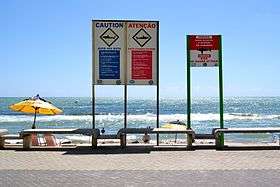
Black December refers to at least nine shark attacks on humans, causing six deaths, that occurred along the coast of KwaZulu-Natal Province, South Africa, from December 18, 1957, to April 5, 1958.[31]
In addition to the four species responsible for a significant number of fatal attacks on humans, a number of other species have attacked humans without being provoked, and have on extremely rare occasions been responsible for a human death. This group includes the shortfin mako, hammerhead, Galapagos, gray reef, blacktip, lemon, silky shark and blue sharks.[2] These sharks are also large, powerful predators which can be provoked simply by being in the water at the wrong time and place, but they are normally considered less dangerous to humans than the previous group.
On the evening of 16 March 2009, a new addition was made to the list of sharks known to have attacked human beings. In a painful but not directly life-threatening incident, a long-distance swimmer crossing the Alenuihaha Channel between the islands of Hawai'i and Maui was attacked by a cookiecutter shark. The two bites, delivered about 15 seconds apart, were not immediately life-threatening.[32]
Types of attacks
Shark attack indices use different criteria to determine if an attack was "provoked" or "unprovoked." When considered from the shark's point of view, attacks on humans who are perceived as a threat to the shark or a competitor to its food source are all "provoked" attacks. Neither the International Shark Attack File (ISAF) nor the Global Shark Attack File (GSAF) accord casualties of air/sea disasters "provoked" or "unprovoked" status; these incidents are considered to be a separate category.[33][34] Postmortem scavenging of human remains (typically drowning victims) are also not accorded "provoked" or "unprovoked" status.[34][35] The GSAF categorizes scavenging bites on humans as "questionable incidents."[34] The most common criteria for determining "provoked" and "unprovoked" attacks are discussed below:
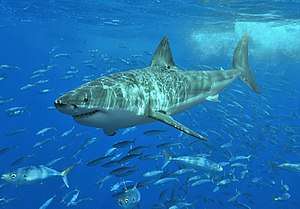
Provoked attack
Provoked attacks occur when a human touches a shark, pokes it, teases it, spears, hooks or nets it, or otherwise aggravates/provokes the animal in a certain manner. Incidents that occur outside of a shark's natural habitat, e.g., aquariums and research holding-pens, are considered provoked, as are all incidents involving captured sharks. Sometimes humans inadvertently "provoke" an attack, such as when a surfer accidentally hits a shark with a surf board.
Unprovoked attack
Unprovoked attacks are initiated by the shark—they occur in a shark's natural habitat on a live human and without human provocation.[33][34] There are three subcategories of unprovoked attack:
- Hit-and-run attack – Usually non-fatal, the shark bites and then leaves; most victims do not see the shark. This is the most common type of attack and typically occurs in the surf zone or in murky water. Most hit-and-run attacks are believed to be the result of mistaken identity.[36]
- Sneak attack – The victim will not usually see the shark, and may sustain multiple deep bites. This kind of attack is predatory in nature and is often carried out with the intention of consuming the victim. It is extraordinarily rare for this to occur.
- Bump-and-bite attack – The shark circles and bumps the victim before biting. Great whites are known to do this on occasion, referred to as a "test bite", in which the great white is attempting to identify what is being bitten. Repeated bites, depending on the reaction of the victim (thrashing or panicking may lead the shark to believe the victim is prey), are not uncommon and can be severe or fatal. Bump-and-bite attacks are not believed to be the result of mistaken identity.[36]
An incident occurred in 2011 when a 3-meter long great white shark jumped onto a 7-person research vessel off Seal Island, South Africa. The crew were undertaking a population study using sardines as bait, and the incident was judged to be an accident.[37]
Reasons for attacks
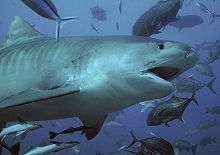
Large sharks species are apex predators in their environment,[38] and thus have little fear of any creature (other than orcas[39]) with which they cross paths. Like most sophisticated hunters, they are curious when they encounter something unusual in their territories. Lacking any limbs with sensitive digits such as hands or feet, the only way they can explore an object or organism is to bite it; these bites are known as test bites.[40] Generally, shark bites are exploratory, and the animal will swim away after one bite.[40] For example, exploratory bites on surfers are thought to be caused by the shark mistaking the surfer and surfboard for the shape of prey.[41] Nonetheless, a single bite can grievously injure a human if the animal involved is a powerful predator such as a great white or tiger shark.[42]
Feeding is not the reason sharks attack humans. In fact, humans do not provide enough high-fat meat for sharks, which need a lot of energy to power their large, muscular bodies.[41]
A shark will normally make one swift attack and then retreat to wait for the victim to die or weaken from shock and blood loss, before returning to feed. This protects the shark from injury from a wounded and aggressive target; however, it also allows humans time to get out of the water and survive.[43] Shark attacks may also occur due to territorial reasons or as dominance over another shark species, resulting in an attack.[44]
Sharks are equipped with sensory organs called the Ampullae of Lorenzini that detect the electricity generated by muscle movement.[45] The shark's electrical receptors, which pick up movement, detect signals like those emitted from fish wounded, for example, by someone who is spearfishing, leading the shark to attack the person by mistake.[44] George H. Burgess, director of the International Shark Attack File, said the following regarding why people are attacked: "Attacks are basically an odds game based on how many hours you are in the water".[46]
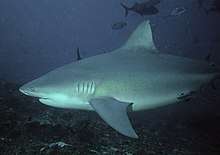
Prevention
Shark nets
In Australia and South Africa shark nets are used to reduce the risk of shark attack. Since 1936 sharks nets have been utilised off Sydney beaches.[48] Shark nets are currently installed at beaches in New South Wales and Queensland; 83 beaches are meshed in Queensland compared with 51 in New South Wales.[48][49] Since 1952, nets have been installed at numerous beaches in South Africa by the KwaZulu-Natal Sharks Board.[50][51]
Shark nets do not offer complete protection but work on the principle of "fewer sharks, fewer attacks". They reduce occurrence via shark mortality. Shark nets such as those in New South Wales are designed to entangle and kill sharks and other animals that pass near them.[52] Reducing the local shark populations is believed to reduce the chance of an attack. Historical shark attack figures suggest that the use of shark nets and drumlines does markedly reduce the incidence of shark attack when implemented on a regular and consistent basis.[53] However, it has been argued that shark nets do not protect swimmers.[52] The downside with shark nets is that they do result in bycatch, including threatened and endangered species.[50] Between September 2017 and April 2018, 403 animals were killed in the nets in New South Wales, including 10 critically endangered grey nurse sharks, 7 dolphins, 7 green sea turtles and 14 great white sharks.[54]
Shark nets have been criticized by environmentalists and conservationists; they say shark nets damage the marine ecosystem.[52][51][55][50] In particular, the current net program in New South Wales has been described as being "extremely destructive" to marine life.[56] Sharks are important to the ecosystem and killing them harms the ecosystem.[50][57][58]
Drum lines
A drum line is an unmanned aquatic trap used to lure, capture and kill large sharks using baited hooks. They are typically deployed near popular swimming beaches with the intention of reducing the number of sharks in the vicinity and therefore the probability of shark attack. Drum lines were first deployed to protect users of the marine environment from sharks in Queensland, Australia in 1962. During this time, they were just as successful in reducing the frequency of shark attacks as the shark nets.[59] More recently, drumlines have also been used with great success in Recife, Brazil where the number of attacks has been shown to have reduced by 97% when the drumlines are deployed.[60] While shark nets and drum lines share the same purpose, drum lines are more effective at targeting the three sharks that are considered most dangerous to swimmers: the bull shark, tiger shark and great white shark.[61] Drum lines are currently used in Queensland.[62][63]
Like with shark nets, drum lines have been criticized by environmentalists, conservationists and animal welfare activists — they say drum lines are unethical, non-scientific, and environmentally destructive; they also say drum lines harm the marine ecosystem.[64][63][65][66][58][67] The current drum line program in Queensland has been called "outdated, cruel and ineffective".[62]
Other protection methods
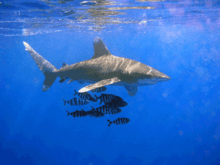
Beach patrols and spotter aircraft are commonly used to protect popular swimming beaches. However aerial patrols have limited effectiveness in reducing shark attacks.[69][70] Other methods include shark tagging efforts and associated tracking and notification systems, capture and translocation of sharks to offshore waters, research into shark feeding and foraging behaviour,[71] public shark threat education programs and encouraging higher risk user groups (surfers, spear-fishers and divers) to use personal shark protection technology.[72]
Media impact
The Jersey Shore shark attacks of 1916 killed 4 people in the first 2 weeks of July 1916 along the New Jersey shore and Matawan Creek in New Jersey. They are generally credited as the beginning of media attention on shark attacks in the United States of America.[73]
In 2010 nine Australian survivors of shark attacks banded together to promote a more positive view of sharks. The survivors made particular note of the role of the media in distorting the fear of sharks.[74] Films such as Jaws were the cause of large-scale hunting and killing of thousands of sharks.[75] Jaws had a significant impact on people and gave them an unrealistic view of sharks, causing them to fear them more than they probably should. The media has continued to exploit this fear over the years by sensationalizing attacks and portraying sharks as vicious man-eaters.[76] There are some television shows, such as the famous Shark Week, that are dedicated to the preservation of these animals.[77] They are able to prove through scientific studies that sharks are not interested in attacking humans and generally mistake humans as prey.
List of notable victims
- George Coulthard (1856–1883), Australian cricketer and Australian rules footballer
- Rodney Fox (1940–), Australian filmmaker and conservationist[78][79]
- Bethany Hamilton (1990–), American surfer
- Mathieu Schiller (1979–2011), French body-boarder
- Brook Watson (1735–1807), British soldier and mayor
See also
References
- ↑ "Yearly Worldwide Shark Attack Summary". International Shark Attack File. Florida Museum of Natural History, University of Florida. Retrieved 2017-11-27.
The 2016 yearly total of 84 unprovoked attacks was on par with our most recent five-year (2011-2015) average of 82 incidents annually.
- 1 2 3 ISAF Statistics on Attacking Species of Shark
- 1 2 3 Edmonds, Molly. "HowStuffWorks "Dangerous Shark 4: Oceanic Whitetip Shark"". Animals.howstuffworks.com. Retrieved 23 September 2010.
- ↑ "La Réunion : un bodyboardeur tué par un requin". 21 February 2017. Retrieved 22 April 2017 – via Le Monde.
- ↑ "World's Confirmed Unprovoked Shark Attacks". International Shark Attack File. 25 August 2015. Retrieved 10 September 2015.
- 1 2 "ISAF Statistics for the Top Ten Worldwide Locations with the Highest Shark Attack Activity (1999–2009)". Florida Museum of Natural History Flmnh.ufl.edu. 25 March 2010. Retrieved 23 September 2010.
- 1 2 3 4 "ISAF 2016 Worldwide Shark Attack Summary". Florida Museum of Natural History. Retrieved 24 April 2017.
- ↑ "ISAF Statistics for the USA Locations with the Highest Shark Attack Activity Since 1999". Flmnh.ufl.edu. 3 May 2010. Retrieved 23 September 2010.
- ↑ Tierney, John (29 July 2008). "10 Things to Scratch From Your Worry List". The New York Times. Retrieved 19 September 2010.
- ↑ "Shark Facts: Attack Stats, Record Swims, More". News.nationalgeographic.com. 28 October 2010. Retrieved 17 August 2012.
- ↑ "Map of United States (incl. Hawaii) Confirmed Unprovoked Shark Attacks". Flmnh.ufl.edu. 26 August 2010. Retrieved 16 February 2012.
- ↑ "WA 'deadiest' for shark attacks – The West Australian". Au.news.yahoo.com. 1 April 2012. Retrieved 17 August 2012.
- 1 2 3 4 Sprivulis, P (2014). "Western Australian Coastal Shark Bites: A risk assessment" (PDF). Aust Med J. 7: 137–42. doi:10.4066/AMJ.2014.2008. PMC 3941575. PMID 24611078. Retrieved 24 April 2017.
- ↑ "Shark hazard warnings, drones may be best hope for reducing risk of attack, experts say". ABC News. Retrieved 25 April 2017.
- 1 2 "Shark attacks and whale migration in Western Australia". Retrieved 25 April 2017.
- ↑ "Clinical features of 27 shark attack cases on La Réunion Island (PDF Download Available)". ResearchGate. Retrieved 2017-07-23.
- ↑ "The World's 10 Deadliest Shark Attack Beaches". The Inertia. Retrieved 25 April 2017.
- ↑ "Map of World's Confirmed Unprovoked Shark Attacks". Flmnh.ufl.edu. 6 January 2011. Retrieved 25 November 2011.
- ↑ "Shark Attack Data Brazil". Shark Attack Data. Retrieved 23 December 2017.
- ↑ "Tubarão: julho é o mês com mais ataques. Saiba como evitá-los". Jornal do Comércio. 18 July 2016. Retrieved 23 December 2017.
- ↑ "Ataques de tubarão em Recife – Conheça a verdade e as causas desse fenômeno". Visitar Recife. 27 November 2015. Retrieved 23 December 2017.
- ↑ "The beautiful Brazilian beaches plagued by shark attacks". BBC. 27 September 2012. Retrieved 23 December 2017.
- ↑ Regenold, Stephen (21 April 2008). "North America's top shark-attack beaches". USA Today. Retrieved 9 April 2010.
- ↑ "The Relative Risk of Shark Attacks to Humans". Flmnh.ufl.edu. Retrieved 23 September 2010.
- ↑ Florida Museum of Natural History, University of Florida. A Comparison with the Number of Lightning Fatalities in Coastal United States: 1959–2006
- ↑ "Hawaiian newspaper article". Honoluluadvertiser.com. Retrieved 23 September 2010.
- ↑ The 1992 Cageless shark-diving expedition by Ron and Valerie Taylor.
- ↑ Cousteau, Jacques-Yves & Cousteau, Philippe (1970). The Shark: Splendid Savage of the Sea. Doubleday & Company, Inc.
- ↑ Bass, A.J., J.D. D'Aubrey & N. Kistnasamy. 1973. "Sharks of the east coast of southern Africa. 1. The genus Carcharhinus (Carcharhinidae)." Invest. Rep. Oceanogr. Res. Inst., Durban, no. 33, 168 pp.
- ↑ Martin, R. Aidan. "Elasmo Research". ReefQuest. Retrieved 6 February 2006.
- ↑ "South Africa Rethinks Use of Shark Nets". Retrieved 22 April 2017.
- ↑ University of Florida News New study documents first cookiecutter shark attack on a live human
- 1 2 Burgess, George H. "ISAF 2011 Worldwide Shark Attack Summary". Global Shark Attack File. Retrieved 26 June 2012.
- 1 2 3 4 "Incident Log". Global Shark Attack File. Retrieved 26 June 2012.
- 1 2 3 4 "ISAF Statistics on Attacking Species of Shark". Global Shark Attack File. 30 January 2012. Retrieved 26 June 2012.
- 1 2 Burgess, George H. "How, When, & Where Sharks Attack". International Shark Attack File. Retrieved 26 June 2012.
- ↑ Rice, Xan (19 July 2011). "Great white shark jumps from sea into research boat". The Guardian. London: Guardian Media Group. Retrieved 20 July 2011.
Marine researchers in South Africa had a narrow escape after a three-metre-long great white shark breached the surface of the sea and leaped into their boat, becoming trapped on deck for more than an hour. [...] Enrico Gennari, an expert on great white sharks, [...] said it was almost certainly an accident rather than an attack on the boat.
- ↑ "Apex Predators Program". Na.nefsc.noaa.gov. Retrieved 23 September 2010.
- ↑ Turner, Pamela S. (Oct–Nov 2004). "Showdown at Sea: What happens when great white sharks go fin-to-fin with killer whales?". National Wildlife. National Wildlife Federation. 42 (6). Retrieved 21 August 2012.
- 1 2 "What To Expect On Your Great White Shark Diving Tour". Romow.com. 7 August 2009. Retrieved 23 September 2010.
- 1 2 Grabianowski, Ed. "HowStuffWorks "How Shark Attacks Work"". Adventure.howstuffworks.com. Retrieved 23 September 2010.
- ↑ Grabianowski, Ed. "HowStuffWorks "Shark Attack Damage"". Adventure.howstuffworks.com. Retrieved 23 September 2010.
- ↑ "Great White Shark". Extremescience.com. Retrieved 23 September 2010.
- 1 2 Grabianowski, Ed. "HowStuffWorks "Shark Sensory System"". Adventure.howstuffworks.com. Retrieved 23 September 2010.
- ↑ "Ampullae of Lorenzini". Marinebiodiversity.ca. Retrieved 23 September 2010.
- ↑ "Shark attacks at record high". BBC News. 9 February 2001. Retrieved 6 April 2010.
- ↑ Curtis, Tobey. "Bull shark". Florida Museum of Natural History, University of Florida. Retrieved 26 June 2012.
- 1 2 Carroll Nick. "Nick Carroll On-Beyond the Panic, The Facts about Shark Nets". Coastal Watch. Retrieved 22 November 2016.
- ↑ Media, Australian Community Media – Fairfax (8 November 2016). "Beyond the panic: the facts about shark nets". Retrieved 22 April 2017.
- 1 2 3 4 "Shark Attacks and the Surfer's Dilemma: Cull or Conserve?". 21 August 2015. Retrieved 22 April 2017.
- 1 2 http://www.sharkangels.org/index.php/media/news/157-shark-nets Shark Nets. Sharkangels.org. Retrieved September 18, 2018.
- 1 2 3 http://www.sealifetrust.org.au/news/latest/shark-nets-australia-work Shark nets in Australia – what are they and how do they work? Sealifetrust.org.au. Retrieved September 18, 2018.
- ↑ "Can governments protect people from killer sharks?". 22 December 2013. Retrieved 22 April 2017.
- ↑ http://www.swellnet.com/news/swellnet-dispatch/2018/08/04/sydney-shark-nets-set-stay-despite-drumline-success Swellnet.com. Sydney shark nets set to stay despite drumline success. Bruce Mackenzie. August 4, 2018. Retrieved September 20, 2018.
- ↑ https://www.sbs.com.au/news/nsw-govt-won-t-back-down-on-shark-nets NSW govt won't back down on shark nets. Sbs.com.au. Retrieved September 18, 2018.
- ↑ https://www.buzzfeed.com/elfyscott/heres-what-you-need-to-know-about-australias-smart-drum?utm_term=.qcNzkX738#.xlDVyOnW7
Here's What You Need To Know About Australia's SMART Drum Lines Being Used To Prevent Shark Attacks. Elfy Scott. July 5, 2018. Retrieved September 18, 2018. - ↑ https://eu.oceana.org/en/importance-sharks Eu.oceana.org. The Importance of Sharks in the Ecosystem. Retrieved September 18, 2018.
- 1 2 Alana Schetzer (8 May 2017). http://pursuit.unimelb.edu.au/articles/sharks-how-a-cull-could-ruin-an-ecosystem "Sharks: How a cull could ruin an ecosystem". Science Matters. University of Melbourne – via Pursuit. Retrieved September 18, 2018.
- ↑ "Archived copy" (PDF). Archived from the original (PDF) on 23 January 2014. Retrieved 26 November 2016.
- ↑ Hazin, F. H. V.; Afonso, A. S. (1 August 2014). "A green strategy for shark attack mitigation off Recife, Brazil". Anim Conserv. 17 (4): 287–296. doi:10.1111/acv.12096. Retrieved 22 April 2017 – via Wiley Online Library.
- ↑ Dudley, Haestier; Cox, Murray. "Shark control: experimental fishing with baited drumlines" (PDf). Retrieved January 22, 2010.
- 1 2 https://www.ntd.tv/2018/09/04/video-endangered-hammerhead-sharks-dead-on-drum-line-in-great-barrier-reef/ Endangered Hammerhead Sharks Dead on Drum Line in Great Barrier Reef. Jack Phillips. Ntd.tv. Retrieved September 18, 2018.
- 1 2 http://www.seashepherd.org.au/apex-harmony/overview/queensland.html Queensland - Overview. Seashepherd.org.au. Retrieved September 18, 2018.
- ↑ http://www.ausmarinescience.com/marine-science-basics/marine-biology/sharks/ Sharks - Marine Science Australia. Ausmarinescience.com. Retrieved September 18, 2018.
- ↑ Calla Wahlquist (12 February 2015). https://www.theguardian.com/australia-news/2015/feb/12/was-serious-threat-shark-policy-condemned-by-senate "Western Australia's 'serious threat' shark policy condemned by Senate". The Guardian. Retrieved September 18, 2018
- ↑ Carl Meyer (2013-12-11). http://theconversation.com/western-australias-shark-culls-lack-bite-and-science-21371 "Western Australia's shark culls lack bite (and science)". Theconversation.com. Retrieved September 18, 2018.
- ↑ Chloe Hubbard (30 April 2017). http://www.nbcnews.com/news/world/no-shark-cull-why-some-surfers-don-t-want-kill-n748141 "No Shark Cull: Why Some Surfers Don't Want to Kill Great Whites Despite Lethal Attacks". NBC News. Retrieved September 18, 2018.
- ↑ Bester, Cathleen. "Oceanic whitetip shark". Florida Museum of Natural History, University of Florida. Retrieved 26 June 2012.
- ↑ Green, M., Ganassin, C. and Reid, D. D. "Report into the NSW Shark Meshing (Bather Protection) Program" (PDF). State of New South Wales through NSW Department of Primary Industries. Retrieved 21 December 2016.
- ↑ Robbins, William D.; et al. (2014). "Experimental evaluation of shark detection rates by aerial observers". PLoS ONE. 9 (2): e83456. doi:10.1371/journal.pone.0083456. Retrieved 19 May 2017.
- ↑ Thousands protest over shark cull in Australia, UK: The Telegraph, 1 February 2014, retrieved 5 January 2017
- ↑ Open letter to WA Government re: Proposal to use drum lines for shark population control and targeting of sharks entering protected beach (PDF), Support Our Sharks, 2013, retrieved 5 January 2017
- ↑ McCall, Matt; 02, National Geographic PUBLISHED July. "2 Weeks, 4 Deaths, and the Beginning of America's Fear of Sharks". National Geographic News. Retrieved 2015-07-28.
- ↑ attack survivors unite to save sharks, Australian Geographic, 14 September 2010
- ↑ Choi, Charles Q. "How 'Jaws' Forever Changed Our View of Great White Sharks". Web. Live Science. Retrieved 29 August 2013.
- ↑ Beryl, Francis, (2011). "Before and after Jaws: Changing representations of shark attacks". researchrepository.murdoch.edu.au. Retrieved 2017-12-06.
- ↑ "Shark Week : Discovery Channel". Dsc.discovery.com. Retrieved 17 August 2012.
- ↑ "Dangerous shores for Jaws". The Olive Press. Luke Stewart Media SL. 28 March 2008. Retrieved 10 December 2016.
- ↑ McGowan, Cliodhna (1 February 2007). "ISDHF looks to permanent home". Caycom Pass. Archived from the original on 16 July 2007. Retrieved 20 June 2009.
External links
- International Shark Attack File
- Global Shark Attack File — Open database
- Peoples Shark Attack File — Online Searchable Open database
- Australian Shark Attack File
- Australasian Shark Attack File — Open database
- Shark Attack Survivors — Shark attack education and prevention
- Shark attack information, statistics, and pictures
- Swim At Your Own Risk — Shark attack news and photos
- Shark Attack News — Shark news, videos & pics
- Shark Attack Data — Database of shark attacks, based on the Shark Research Institute's Global Shark Attack File